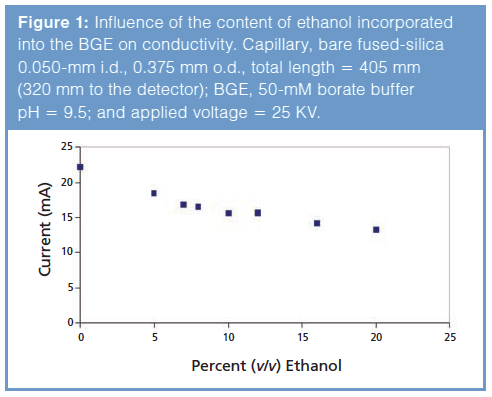Fundamental and Practical Aspects of Liquid Chromatography and Capillary Electromigration Techniques for the Analysis of Phenolic Compounds in Plants and Plant-Derived Food, Part 2: Capillary Electromigration Techniques
LCGC Europe
Analytical separation techniques based on the differential migration velocities of analytes under the action of an electric field are gaining increasing acceptance for the analysis of phenolic compounds in edible and medicinal plants and in plant-derived food products. In Part 2 of this review article the authors discuss the fundamental principles and practical aspects of electromigration techniques, including capillary zone electrophoresis (CZE), micellar electrokinetic chromatography (MEKC), and capillary electrochromatography (CEC). The development of two-dimensional systems, performed by coupling either liquid chromatography (LC) with an electromigration technique or two electromigration techniques, operated under different separation mechanisms, is also discussed.
Photo Credit: Skyler Ewing/Shutterstock.com

Analytical separation techniques based on the differential migration velocities of analytes under the action of an electric field are gaining increasing acceptance for the analysis of phenolic compounds in edible and medicinal plants and in plant-derived food products. In Part 2 of this review article the authors discuss the fundamental principles and practical aspects of electromigration techniques, including capillary zone electrophoresis (CZE), micellar electrokinetic chromatography (MEKC), and capillary electrochromatography (CEC). The development of two-dimensional systems, performed by coupling either liquid chromatography (LC) with an electromigration technique or two electromigration techniques, operated under different separation mechanisms, is also discussed.
The first part of this review article focused on fundamental concepts and practical aspects of liquid chromatography (LC) applied to the analysis of phenolic compounds in edible and medicinal plants and in plant-derived food products (1). The paper also briefly discussed the chemical structure and the distribution of the major phenolic compounds occurring in the plant kingdom-which are divided into different subclasses-and how they form an integral part of the human diet and possess a variety of health-promoting properties. This review also briefly addressed the main methods employed for sample preparation and extraction.
A variety of microscale analytical separation methods use a pool of techniques based on the differential migration velocities of analytes under the action of an electric field, which are referred to as capillary electromigration (CE) techniques. These separation techniques are performed in capillary tubes, typically with an internal diameter (i.d.) of 20–100 μm, and may depend on electrophoresis, the transport of charged species through a medium by an applied electric field, or on electrically driven mobile phases to achieve an effective chromatographic separation. Therefore, the electric field may either cause the separation mechanism or just promote the flow of a solution throughout the capillary tube, in which the separation takes place-or both.
Part 2 discusses fundamental and practical aspects of a variety of instrumental analytical separation techniques, based on electromigration principles that, as well as LC, are suitable for the separation, identification, and quantification of phenolic compounds in plant materials and plant-derived food products.
Capillary Electromigration Techniques
In addition to high performance liquid chromatography (HPLC) and ultrahigh-pressure liquid chromatography (UHPLC), which are still the techniques of choice for the analysis of phenolic compounds, CE using capillary tubes with a typical internal diameter and length of 20–100 μm and 20–100 cm, respectively, are gaining increasing interest in this field. Capillary electromigration techniques can be performed using a variety of modes, based on different separation mechanisms that can be selected by simply changing the operational conditions, in particular the composition of the electrolyte solution, which may consist of either a continuous or a discontinuous electrolyte system (2). The separation modes mostly employed for the analysis of phenolic compounds are capillary zone electrophoresis (CZE) and micellar electrokinetic chromatography (MEKC), also referred to as micellar electrokinetic capillary chromatography (MECC). Both separation modes use continuous electrolyte systems, which involves background electrolyte (BGEs) solutions whose composition is constant along the capillary tube.
As in HPLC and UHPLC, the detectors primarily used are variable-wavelength and photodiode array (PDA) spectrophotometers. The detection is performed on-column through a “window” obtained by removing a small portion of the polyimide external coating of the fused-silica capillary tube, usually the cathodic end, where the detection takes place. The main drawback of photometric on-column detection is the short distance the light travels through the capillary (the optical path length), corresponding to the internal diameter of the capillary tube. Other detection modalities include electrochemical detection, which is based on conductometric, amperometric, voltametric, and potentiometric measurements, and hyphenation with mass spectrometry (MS), whereas the hyphenation with other techniques, such as mid-infrared (MIR) spectroscopy is limited (3–4).
Capillary electromigration techniques are commonly hyphenated with MS by two major types of electrospray ionization (ESI) interfaces, which are identified as coaxial sheath-flow and sheath-less interfaces (5). The most commonly used arrangement is the coaxial sheath-flow interface, consisting of two concentric tubes surrounding the separation capillary, which are devoted to delivering the sheath-liquid and the nebulizing gas. The function of the sheath liquid is to provide electrical contact, compatible solvent composition for ionization, and evaporation independent of the nature of the BGE, as well as flow rate matching the requirements of the ionization interface. Moreover, sheath-flow interfaces offer the possibility to add a reagent capable of undergoing specific reactions with certain analytes to the sheath-liquid. For example, the addition of DPPH (2,2-diphenyl-1-picrylhydrazyl) to the sheath-liquid has been proven to be a fast screening tool for studying antioxidant characteristics of plant phenolic compounds (6).
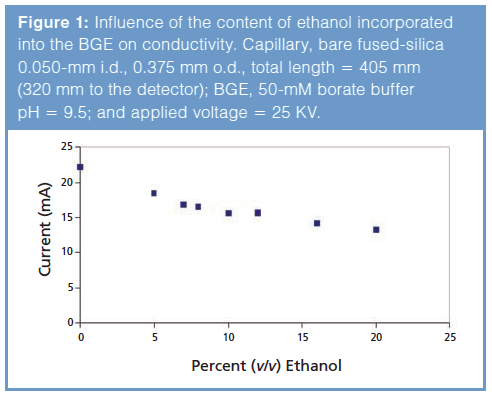
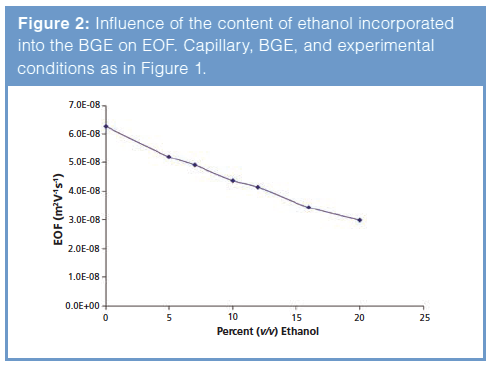
Capillary Zone Electrophoresis
Phenolic compounds are separated by CZE using continuous electrolyte solution systems and constant electric field strength throughout the capillary length, either in aqueous or nonaqueous BGEs. The separation mechanism is based on differences in the electrophoretic mobilities of charged species and, therefore, on differences in their charge-to-mass ratio. Under the influence of the electric field applied across the capillary tube, the charged analytes migrate with different velocities towards the corresponding electrode-positively charged analytes towards the cathode and negatively charged analytes towards the anode. However, in the presence of sufficiently strong electroosmotic flow (EOF)-the stream of liquid induced by the applied potential across the capillary tube-cations, anions, and neutral species migrate in the direction of EOF, where the sample detection takes place.
In general, phenolic compounds are assayed by CZE using an alkaline buffer to promote their ionization, which mostly depends on their pKa values, ranging between approximately 7 and 12 for flavonoids and between approximately 4 and 12 for phenolic acids, respectively, depending on the molecular structure of the phenolic compounds. However, pH values higher than 10 are generally avoided to prevent the possible oxidation of these compounds, which are known to be rather reactive with the dissolved oxygen in alkaline solutions. In addition, the ability of borate ions to form negatively charged complexes with vicinal –OH groups of polyhydric phenolic compounds has been used to modulate the electromigration behaviour of these analytes, which are typically analyzed in tetraborate buffer at pH values ranging between 9 and 10.
The CZE separation of phenolic compounds as borate complexes is usually optimized by incorporating an organic solvent into the BGE, which influences the formation of the borate complexes and changes viscosity and relative permittivity of the buffer solution, with consequent selective variations of the electrophoretic mobility of the charged analytes. The additional positive effects of the incorporation of an organic solvent into the BGE are the decrease in the electrical current, with consequent reduction of Joule heating and peak band broadening, and the reduction of EOF, resulting in an increase of the analyte migration time window. The influence of the content of ethanol incorporated into the BGE on conductivity and EOF is depicted by the plots displayed in Figures 1 and 2, respectively.
By increasing the borate concentrations in the BGE, the extent of complex formation with vicinal diol groups is expected to increase, leading to longer analysis time and larger differences in separation selectivity. Nevertheless, limited practical effects on resolutions are obtained by increasing the concentration of the borate buffer, as well as by changing its pH, which can be varied within the range of the buffering capacity of the borate solutions and the limits of concentration compatible with the requested low electrical conductivity of the BGE.
The electropherograms reported in Figure 3 represent an example of standard phenolic compounds separated by CZE as borate complexes without and with the incorporation of an organic solvent into the BGE, consisting of 50-mM borate buffer at pH 9.5. It is observed (Figure 3[b]) that the incorporation of 16% (v/v) ethanol into the BGE brings about the complete resolution of the selected 11 phenolic compounds, otherwise only partially separated in the absence of ethanol (Figure 3[a]).
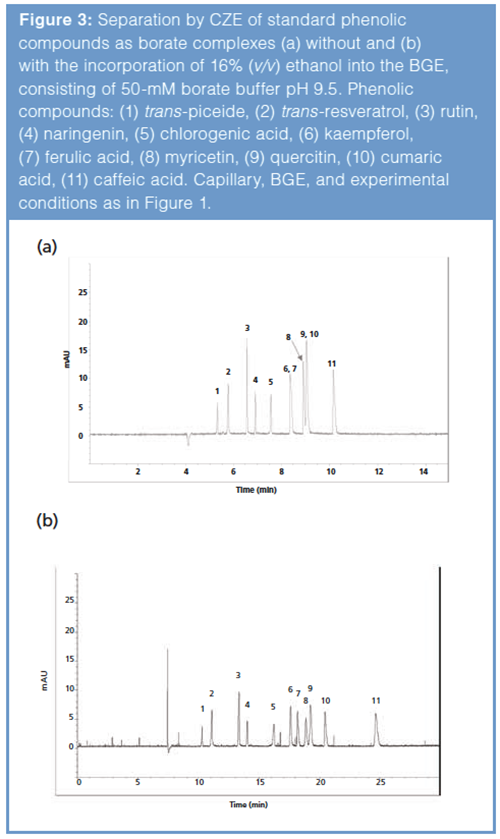
CZE methods based on the analytical approach described above have been developed for the analysis of phenolic compounds occurring in a variety of plants and plant-derived food, including herbal teas (7), olive oil (8), and medicinal plants (9–10). Proposed modifications of this approach include the use of mixed phosphate-borate buffers (11), and the incorporation of additives into the borate buffer, such as the ionic liquid 1-butyl-3-methylimidazolium tetrafluoroborate for the separation of isoflavones (12) or the chiral selector 2-hydroxypropyl-γ-cyclodextrin for the separation of flavanone enantiomers (13). In addition to the well established BGEs discussed previously, phosphate buffer was recently employed in CZE for analyzing phenolic acids in Italian wheat samples (14) and in Irish whiskies by a field amplified sample staking (FASS) pre-concentration method (15).
Micellar Electrokinetic Chromatography
Micellar electrokinetic chromatography uses electrolyte solutions incorporating a surfactant at a concentration higher than its critical micelle concentration (CMC) that forms micelles acting as a pseudo-stationary phase dispersed into the BGE. This separation mode extends the application of the electromigration techniques to noncharged molecules. The mechanism of separation is based on the distribution of the analytes between the pseudo-stationary phase, formed by the dispersed micelles and the surrounding solution. Noncharged analytes that do not interact at all with the micelles migrate at the same velocity of EOF, whereas those participating to reversible interactions with the micelles migrate at the velocity of the micelles when they are associated with them and at the velocity of EOF when they are in the bulk solution. Therefore, the migration velocity of these analytes, which is comprised between EOF and the electrophoretic mobility of micelles, is proportional to the time they migrate associated with the micelles and, consequently, to the strength of their interaction with the dispersed phase (2).
Composition and pH of the electrolyte solution employed in MEKC are selected to generate a sufficiently high EOF to transport micelles and analytes towards the detection windows. Sodium dodecyl sulphate (SDS) is by far the most widely used surfactant because of its relatively low cost, its availability in highly purified forms, and low CMC in aqueous solution (8 mM), above which it forms almost spherical anionic micelles with the charged heads oriented towards the solution and the hydrophobic tails pointing towards the aggregate. SDS is incorporated into the BGE at neutral to alkaline pH values to ensure strong EOF with bare fused-silica capillaries. Under these conditions, the anionic micelles migrate in the opposite direction to EOF and, therefore, are transported towards the cathode with a migration velocity slower than the stream of the bulk flow of BGE.
The use of acidic BGEs has been rarely applied for the separation of phenolic compounds by MEKC, mainly as a result of the low EOF generated at low pH values, which hinders the migration of the negatively charged micelles towards the cathodic end of the capillary, where the detection take place. Nevertheless, procyanidins have been efficiently separated by MEKC using 100-mM SDS in 0.1 M acetate buffer pH 5.0 (16).
MEKC is particularly suitable to separate phenolic compounds with similar structure but different lipophilicity. Generally, unsaturation of the C-ring lowers hydrophobicity and, consequently, the migration time; methylation of the hydroxyl group increases the hydrophobicity of the analyte and, accordingly, its affinity to the micelles, which results in increasing migration times; glycosylation and higher number of –OH groups increases hydrophilicity and therefore the migration time decreases.
The on-line hyphenation of MEKC with mass spectrometry (MEKC–MS) is often hampered by the incorporation of the surfactant into the BGE, which suppresses ionization efficiency and contaminates the inlet of the mass spectrometer. Possible approaches to overcome these limitations include the selection of the (semi)volatile surfactants perfluorooctanic acid and perfluorooctane sulfonic acid (17), the use of anodically migrating micelles (18), and the use of either a sheathless porous-tip interface (19) or a desorption electrospray ionization (DESI) interface (20).
As well as the surfactant, a variety of additives or organic solvents can also be incorporated into the BGE to modulate selectivity and peak capacity. The formation of inclusion complexes of cyclodextrins with charged and uncharged phenolic compounds have been widely studied for their ability to influence the migration behaviour of these compounds in MEKC. For example, the incorporation of β-cyclodextrin into the BGE has proven to improve the resolution of flavonoids in MEKC, performed with phosphate-borate buffer at pH 9.8 containing 100-mM SDS (21). Moreover, the formation of inclusion complexes of sulphated-β-cyclodextrin with catechins has been used to improve the separation of these phenolic compounds extracted from green tea infusions by MEKC (22). Also effective in improving the separation of flavonoids-extracted from the aerial part of an Argentinian medicinal plant (Ligaria cuneifolia)-has been the incorporation of a mixture of β-cyclodextrin (5 mM) and sulphated-β-cyclodextrin (2% w/v) into the BGE, consisting of 50-mm SDS in 20-mm borate buffer (pH 8.3) (23).
The suitability of β-cyclodextrin as an additive of the BGE employed in MEKC has also been explored in combination with the ionic liquid 1-butyl-3-methylimidazolium tetrafluoroborate. Both additives have been incorporated into the BGE-consisting of SDS in phosphate-borate buffer-to improve the simultaneous separation by MEKC of seven phenolic acids and four diterpene quinones in three Salvia species (24). The same ionic liquid has also been incorporated into the BGE-consisting of polyoxyethylene sorbitan monolaurate (Tween 20) and sodium borate at pH 9.2-to modify the separation performance of phenolic acids in MEKC (25).
The separation window, corresponding to the time difference between the velocity of EOF and anionic micelles, and resolution of phenolic compounds in MEKC are also modulated by incorporating an organic solvent into the BGE. The organic solvents influence EOF, the rate of inclusion complex formation, the hydrophobic interactions of phenolic compounds with nonpolar additives, and the CMC of the surfactant. Methanol and acetonitrile are the organic solvents most often used in MEKC of phenolic compounds (26), although the influence of other organic solvents has been tested too (27).
CE in Two-Dimensional Separation Systems
Phenolic compounds are separated by CZE according to differences in their mass-to-charge ratio, whereas their separation by reversed phaseâHPLC depends on differences in their hydrophobicity. These two diverse separation mechanisms are independent of each other and, consequently, provide complementary selectivity. This can be witnessed by plotting the migration times of phenolic compounds in CZE versus their retention times in reversed phase-HPLC, as shown in Figure 4. Significant differences in selectivity are also expected between CZE and MEKC, whose separation mechanism for uncharged analytes is based on their distribution between the dispersed micelles and the surrounding solution.
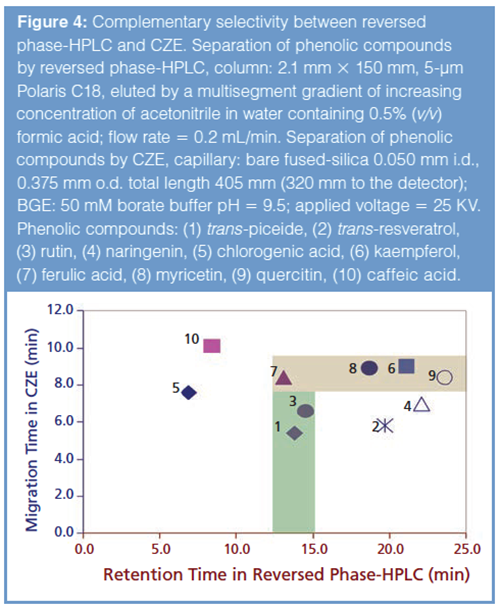
Thus, two-dimensional (2D) separation systems, performed by coupling LC with CE, appear to be an interesting option, offering a potentially high degree of orthogonality. However, the direct hyphenation of LC with CE requires a variety of problems to be overcome. These arise from the differences between the dimensions of the chromatographic column and the capillary tube used in CE, the different flow rates and composition of the liquid phase passing throughout them, and the need to complete the electric circuit to apply the high voltage across the capillary tube for electrophoresis. Although CE can be used either in the first or in the second dimension, its use in the second dimension is more common, as first proposed by Jorgenson (28).
It is noteworthy that CE offers the possibility of performing two-dimensional separations using either a single capillary column (29) or, as in 2D LC, two different columns coupled by an interface or a multiple-port switching valve (30–31). The alternative and more applied approach is the offline hyphenation of LC and CE, in which only the fractions of the effluent from the first dimension-those containing the analytes of interest-are collected and subsequently separated in the second dimension.
The majority of the 2D separation systems containing at least one electromigration separation technique have been developed for peptide and protein analysis and proteome investigations. Nevertheless, remarkable applications of these 2D systems for the analysis of phenolic compounds in plants and food matrices of plant origin have been reported. Reversed phase-HPLC has been successfully combined offline with CZE for the separation and identification of phenolic compounds extracted from extra virgin olive oil. The 2D separation system involved the use of a semipreparative reversed phase column in the first dimension, the manual collection of the fractions containing unresolved phenolic compounds, and their subsequent analysis in the second dimension by CZE with on-line quadrupole time-of-flight (QTOF)-MS detection, using an orthogonal electrospray interface (32).
Complex mixtures of phenolic compounds have also been successfully separated coupling offline reversed phase chromatography with MEKC, as reported by Jandera et al. (33). They developed an automated offline LC-MEKC system for the separation of flavones and phenolic acid by reversed phase chromatography in the first dimension and MEKC in the second dimension. Reversed phase chromatography was performed with a polyethylene glycol (PEG) reversed phase column, eluted by a gradient of increasing concentration of acetonitrile in the mobile phase, whereas SDS and heptakis(6-O-sulfo)-β-cyclodextrin were incorporated into the BGE used for the MEKC separation. An autosampler was used as the interface between the LC and the MEKC separation systems and the outlet of the reversed phase column was connected to the autosampler via a six-port switching valve. The fractions of the effluent from the LC column, collected into the vials of the autosampler, were subsequently analyzed in the MEKC second dimension, using spectrophotometric UV detection at 280 nm.
Applications of 2D systems in a single capillary have been reported for the separation and quantification of flavonoids in the herbaceous perennial plants Leonurus cardiaca (34), using MEKC as the first dimension and CZE with electrochemical detection as the second dimension. A 2D MEKC–CZE system in a single capillary, involving the on-line combination of sweeping with electrokinetic injection and analyte focusing by micelle collapse, has also been reported for the separation and quantification of flavonoids in the medicinal plant Herba Leonuri (35).
Capillary Electrochromatography
Capillary electrochromatography (CEC) uses capillary columns similar to those employed in nano-LC, with the difference being that in CEC the mobile phase is flushed through the column by EOF, rather than by a mechanical pump. The result is that the flow of the mobile phase passing throughout the CEC capillary column displays a flat plugâlike profile, which does not contribute to peak broadening. This is in contrast to the laminar or parabolic flow profile generated in LC, where there is a strong pressure drop across the column caused by frictional forces at the liquid–solid boundary. Moreover, the absence of column backpressure also allows CEC to be performed with capillary columns of low permeability, such as those packed with sub-2-μm particles. On the other hand, the column length is limited by the value of the electric field requested to obtain the desired flow rate with commercially available power supplies, which usually consent to applying up to 30 kV. It is also noteworthy that only the isocratic elution mode is allowed with common commercially available instrumentation.
The capillary column can be either filled, packed, or coated with a stationary phase, which provides the sites for the required interactions with the analytes and charged groups for the generation of the EOF needed to ensure the movement of the mobile phase through the column. Stationary phases carrying cationic functional groups, such as amino or ammonium groups, generate anodic EOF, whereas stationary phases with anionic functionalities, such as sulphonic or acetic groups, generate cathodic EOF. The stationary phase may also carry zwitterionic groups and in this case exhibits either cathodic or anodic EOF, according to the pH of the mobile phase.
Capillary columns containing in situ prepared monolithic separation media, formed from either organic polymers or silica, offer the advantage of circumventing the fabrication of frits at both ends of the capillary tube, which is otherwise necessary to retain the particles inside the packed columns-a critical step in the preparation of homemade CEC columns. The organicâbased monolithic columns are generally made of a mixture of monomers, crosslinkers, and porogens by radical polymerization, which is conducted directly within the confine of a capillary. Porous size and distribution, as well as EOF and retentive properties of polymer-based monolithic columns, can be easily tailored by tuning the composition of the reaction mixture, which can be composed of a variety of ionizable monomers, neutral reactants, and porogenic solvents at different percentages.
A homogeneous monolithic CEC column, prepared by photo-polymerization of (3-allyl-1-imidazol)propane sulfonate, has recently been used for the efficient separation of phenolic acids in coffee beans (36). The separation was performed using a mixture of acetonitrile and water, containing 12-mM ammonium acetate at pH 8.5, as the mobile phase. The on-column revelation of the separated phenolic acids was performed by PDA detection at 280 nm. A combination of hydrophobic and electrostatic interactions between the zwitterionic stationary phase and the charged phenolic acids was considered to influence the separation mechanism.
Other applications of CEC using polymer-based monolithic capillary columns include the separation of coumarins extracted from Fructus cnidii, using a poly(butyl methacrylate-co-ethylene dimethacrylate-co-[2-(methacryloyloxy)ethyl] trimethylammonium chloride) homemade monolithic column (37). The separation and quantification of isopimpinelline, bergapten, imperatorin, and osthole was obtained in less than five minutes using an hydro-organic mobile phase, containing 50% (v/v) acetonitrile and aqueous 10 mM sodium dihydrogen phosphate solution at pH 4.95. A lauryl acrylate ester-based monolithic column has been developed for studying the phenolic fraction of extra virgin olive oils (EVOO). Using a linear discriminant analysis, the phenolic profiles determined by CEC were able to classify the EVOO samples belonging to three different geographical origins (Croatia, Italy, and Spain), without identifying the separated phenolic compounds (38).
A method for the identification and quantification of 10 phenolic compounds in EVOO by CEC has been developed by Fanali et al. using silica-based reversed phase columns (39). The study evaluated the performance of several types of C8 and C18 stationary phases and the optimum separation was obtained using bidentate C18 particles packed in a 23-cm silica tube (75-mm i.d.) and eluted by a hydroâorganic mobile phase. The method allowed the efficient separation, identification, and quantification of protocatechuic, p-coumaric, o-coumaric, vanillic, ferulic, caffeic, syringic acids, hydroxytyrosol, tyrosol, and oleuropein in less than 35 min.
A capillary column packed with bidentate C18 particles has also been successfully used in CEC for the rapid and efficient separation and quantification of catechins and methylxantines in green and black teas, including (+)-catechin, (–)-epicatechin, (–)-epigallocatechin, theophylline, and caffeine (40). Fanali has also developed an aminoâfunctionalized spherical ordered mesoporous silica that, when packed in 100-μm i.d. fused-silica capillary tubes, has been successfully used in CEC for enantio- and diastereomeric separations (41). Efficient and rapid stereoisomer resolution of a variety of flavonoids and flavanones glycosides has been obtained in reversed phase mode, using a mixture of methanol–water as the mobile phase with ammonium acetate buffer at pH 4.5 and at different volume ratios.
Conclusions
CZE and MEKC are the most popular separation modes employed using CE for phenolic compounds, which are generally separated by CZE as borate complexes at alkaline conditions (pH 9–10). Borate buffer is also the BGE of choice when using MEKC for neutral phenolic compounds as a result of its optimum buffering capacity at pH values that ensure strong EOF and the capability of the borate ions to form negatively charged complexes with vicinal –OH groups of polyhydric phenolic compounds. However, borate buffer, as well as other nonvolatile buffers, and the majority of surfactants employed in MEKC are not suitable for on-line hyphenation of this technique with MS, which has found limited applications for the analysis of phenolic compounds.
As well as the surfactant, several additives and organic solvents are currently incorporated into the BGE to modulate selectivity and peak capacity. Examples of this approach include the use of cyclodextrins, which form inclusion complexes with charged and uncharged phenolic compounds and, therefore, influence their migration behaviour in MEKC.
A high degree of orthogonality is potentially possible by the hyphenation of reversed phase chromatography with either CZE or MEKC, as well as by the combination of two different electromigration separation techniques, such as MEKC and CZE, either using one single or two different capillary tubes. However, the direct hyphenation of LC with CE is hampered by the need to solve several technical problems arising from instrumental and operational differences, limiting its applications. Also modest are the applications of CEC for the analysis of phenolic compounds occurring in edible and medicinal plants and in plant-derived food and dietary supplements, mainly because isocratic elution mode is solely possible with common commercially available CEC instrumentation and the restricted number of commercially available CEC columns.
Currently, a wide selection of techniques are available for the separation and identification of natural phenolic compounds. However, the ever increasing interest of scientists, food producers, and society in healthy food and dietary supplements is expected to boost the development of more advanced methods for both sample preparation and analysis of phenolic compounds, as well as other plant specialized metabolites with health-promoting properties.
References
- D. Corradini, F. Orsini, L. De Gara and I. Nicoletti, LCGC Europe31(9), 480–490 (2018).
- D. Corradini, in Handbook of HPLC, D. Corradini, Ed. (CRC Press, Boca Raton, USA, 2nd ed., 2010), pp.155–206.
- A. Beutner, R. Rodrigues Cunha, E.M. Richter, and F.M. Matysik, Electrophoresis37, 931–935 (2016).
- J. Kuligowski, A. Quintás, M. de la Guardia, and B. Lendl, Anal. Chim. Acta679, 1640–1652 (2017).
- G. Bonvin, J. Schappler, and S. Rudaz, J. Chromatogr. A1267, 17–31 (2012).
- L. Maringer, E. Ibáñez, W. Buchberger, C.W. Klampfl, and T.J. Causon, Electrophoresis36, 348–354 (2015).
- W.J. Arries, A.G.J. Tredoux, D. de Beer, E. Joubert, and A. de Villiers, Electrophoresis38, 897–905 (2017).
- M. de los Angeles de Fernandez, V.C. SotoVargas, and M.F. Silva, J. Am. Oil Chem. Soc.91, 2021–2033 (2014).
- L.S. Müller, G. Domingos da Silveira, V. Dal Prá, O. Lameira, C. Viana, and L. Machado de Carvalho, J. Liq. Chromatogr. Relat. Technol.39, 13–20 (2016).
- Y. Deng, S.-C-Lam, J. Zhao, and S.P. Li, Electrophoresis38, 2654–2661 (2017).
- Z.-Y. Ren, Y. Zhang, and Y.P. Shi, Talanta78, 959–963 (2009).
- W. Xiao, F.Q. Wang, C.H. Li, Q. Zhang, Z.N. Xia, and F.Q. Yang, Anal. Methods7, 1098–1103 (2015).
- J. Pan, S. Zhang, L. Yan, J. Tai, Q. Xiao, K. Zou, Y. Zhou, and J. Wu, J. Chromatogr. A1185, 117–129 (2008).
- R. Gotti, E. Amadesi, J. Fiori, S. Bosi, V. Bregola, I. Marotti, and G. Dinelli, J. Chromatogr. A1532, 208–215 (2018).
- B. White, M.R. Smyth, and C.E. Lunte, Anal. Methods9, 1248–1252 (2017).
- A. Cifuentes, B. Bartolomé, and C. Gómez-Cordovés, Electrophoresis22, 1561–1567 (2001).
- Y. Ishihama, H. Katayama, and N. Asakawa, Anal. Biochem.287, 45–54 (2000).
- L. Yang, A.K. Harrata, and C.S. Lee, Anal. Chem.69, 1820–1826 (1997).
- D. Moreno-González, R. Haselberg, L. Gámiz-Gracia, A.M. GarcìaâCampaÅa, G.J. de Jong, and G.W. Somsen, J. Chromatogr. A1524, 283–289 (2017).
- G.K. Barbula, S. Safi, K. Chingin, R.H. Perry, and R.N. Zare, Anal. Chem. 83, 1955–1959 (2011).
- L. Jiang, G. Fang, Y. Zhang, G. Cao, and S. Wang, J. Agric. Food Chem. 56, 11571–11577 (2008).
- R.G. Peres, F.G. Tonin, M.F.M. Tavares, and D.B. Rodriguez-Amaya, Food Chem.127, 651–655 (2011).
- B. Dobrecky, S.A. Flor, P.G. Lopez, M.L. Wagner, and S.E. Lucangio, Electrophoresis38, 1292–1300 (2017).
- J.L. Cao, J. Hu, J. Wei, B.C. Li, M. Zhang, C. Xiang, and P. Li, Molecules 20, 15304–15318 (2015).
- L. Liu, B. Wu, K. Liu, C.-R. Li, X. Zhou, P. Li, and H. Yang, J. Pharm. Biomed. Anal.126, 1–8 (2016).
- R. Martí, M. Valcárcel, J.M. Herrero-Martínez, J. Cebolla-Cornejo, and S. Roselló, Food Chem.221, 439–446 (2017).
- M. Ganzera, C. Egger, C. Zidorn, and H. Stuppner, Anal. Chim. Acta614, 196–200 (2008).
- M.M. Bushey and J.W. Jorgenson, Anal. Chem.62, 978–984 (1990).
- C. Kukusamude, S. Srijaranai, and J.P. Quirino, Anal. Chem. 86, 3159–3166 (2014).
- L. Ranjbar, A.J. Gaudry, M.C. Breadmore, and R.A. Shellie, Anal. Chem. 87, 8673–8678 (2015).
- Y. Li, X. Fang, S. Zhao, T. Zhai, X. Sun, and J.J. Bao, Chem. Lett.39, 983–985 (2010).
- R. Garcia -Villalba, A. Carrasco-Pancorbo, A. Vázquez-Martìn, C. Oliveras-Ferraros, J.A. Menéndez, A. Segura-Carretero, and A. Fernández-Gutiérrez, Electrophoresis30, 2688–2701 (2009).
- P. Cesla, J. Fischer, and P. Jandera, Electrophoresis31, 2200–2210 (2010).
- X. Zhang and Z. Zhang, J. Chromatogr. B879, 1641–1646 (2011).
- Z. Zhang, X. Du, and X. Li, Anal. Chem.83, 1291–1299 (2011).
- A. Murauer, R. Bakry, H. Schottenberger, C. Huck, and M. Ganzera, Anal. Chim. Acta963, 1336–1342 (2017).
- J. Wang, D. Chen, Z. Chen, G. Fan, and Y. Wu, J. Sep. Sci.33, 1099–1108 (2010).
- M.J. Lerma-García, C. Lantano, E. Chiavaro, L. Cerretani, J.M. Herrero-Martínez, and E.F. Simó-Alfonso, Food Res. Int.42,
- 1446–1452 (2009).
- Z. Aturki, S. Fanali, G. D’Orazio, A. Rocco, and C. Rosati, Electrophoresis29, 1643–1650 (2008).
- U.D. Uysal, Z. Aturki, M.A. Raggi, and S. Fanali, J. Sep. Sci.32, 1002–1010 (2009).
- M. Silva, D. Pérez-Quintanilla, S. Morante-Zarcero, I, Sierra, M.L. Marina, Z. Aturki, and S. Fanali, J. Chromatogr. A1490, 166–176 (2017).
Danilo Corradini earned his Ph.D. in chemistry at Sapienza University of Rome (Italy) and received postdoctoral education in separation science at the Department of Chemical Engineering, Yale University (USA). His research interests include the study of fundamental and practical aspects of HPLC and electromigration techniques for analytical separations of biomolecules, mainly of plant origin. In recognition of his scientific contributions, he has received the Csaba Horváth Memorial Award in 2009, the Central European Group for Separation Science Award in 2011, and the Arnaldo Liberti Medal in 2014.
Francesca Orsini is a registered nutritionist in the register of the Italian Biologists. She received her bachelor degree in food science and human nutrition in 2012 and master’s degree in food technology and science nutrition in 2014. She completed her education with a Ph.D. in bioengineering and biosciences in 2018 at the University Campus Bio-Medico of Rome. Her research domains include development of sample preparation procedures and chromatographic analytical methods for bioactive compounds in plant material.
Laura De Gara is Full Professor of plant physiology and head of the master’s degree in food science and human nutrition at the Campus Bio-Medico University of Rome. She has almost 30 years of experience in studying plant metabolism with particular attention to redox homeostasis and signalling in response to environmental conditions. She is also interested in plant metabolites with nutritional and healthy effects, in particular polyphenols, fructans, and other fibres, as well as antioxidant vitamins.
Isabella Nicoletti was educated as a biologist at Sapienza University of Rome, where she was also a postdoctoral fellow at the Department of Chemistry from 1982 to 1985. Since 1985 she has been a research scientist at the Institute of Chemical Methodologies of the Italian Research Councilin Montelibretti (Rome). She is an expert in the field of separation science, and is interested in the development of chromatographic techniques for innovative analytical methods for foods with determined healthy prerogatives.

New Study Reviews Chromatography Methods for Flavonoid Analysis
April 21st 2025Flavonoids are widely used metabolites that carry out various functions in different industries, such as food and cosmetics. Detecting, separating, and quantifying them in fruit species can be a complicated process.
Analytical Challenges in Measuring Migration from Food Contact Materials
November 2nd 2015Food contact materials contain low molecular weight additives and processing aids which can migrate into foods leading to trace levels of contamination. Food safety is ensured through regulations, comprising compositional controls and migration limits, which present a significant analytical challenge to the food industry to ensure compliance and demonstrate due diligence. Of the various analytical approaches, LC-MS/MS has proved to be an essential tool in monitoring migration of target compounds into foods, and more sophisticated approaches such as LC-high resolution MS (Orbitrap) are being increasingly used for untargeted analysis to monitor non-intentionally added substances. This podcast will provide an overview to this area, illustrated with various applications showing current approaches being employed.

.png&w=3840&q=75)

.png&w=3840&q=75)



.png&w=3840&q=75)



.png&w=3840&q=75)
